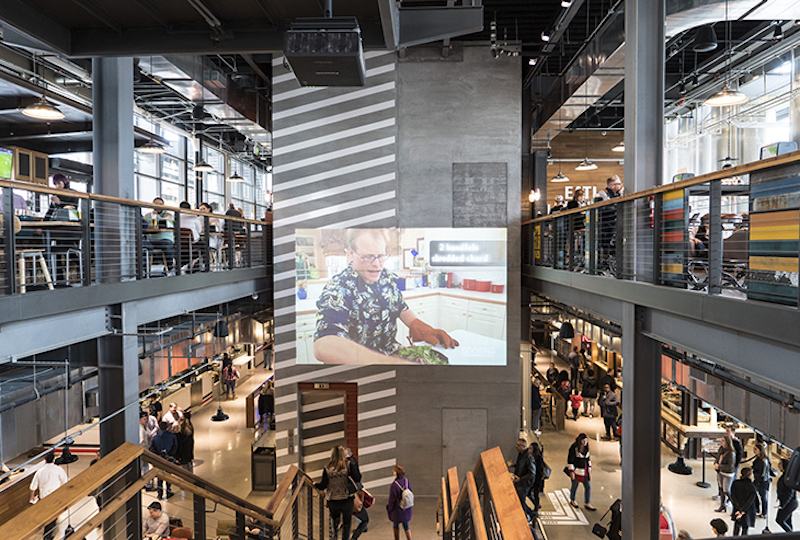Cities and suburbs are constantly changing and 2017 served up more than its share of challenges—some we saw coming (massive retail closures), while others took us by surprise (historic flooding and other natural disasters).
2017 saw the continuation of the evolution of expectations on the part of consumers, developers, office workers, and cities. Those expectations? Urban design and development is no longer “business as usual.” In that spirit, here are six urban design trends to watch in 2018:
1. Experience, Not Just Place
“Place-making,” once the watchword of every urban designer, is no longer enough. Now it is all about experience—how buildings and the spaces between them are treated in relation to human-scale design. Developers are rediscovering the importance of leveraging authenticity and contextualism—“franchise architecture” and cookie-cutter designs are out. Experience has real dollar value—from adjacency to open space to unique developments as destinations. Experience brings customers back again and again—not just for the retail offerings, but also for the sense of belonging and ownership.
2. Retail Reinvention
No doubt 2017 was the year of retail upheaval. Last year, over 6,700 stores closed across the United States (more if you include restaurant closures), and 3,900 more are projected to shutter in 2018. Retail analysts also predict a seismic shift in regional malls, with as many as 25 percent in danger of closure. Amazon and online sales may be convenient scapegoats, but mergers and acquisitions, changing consumer habits, and the oversaturation of retail for the past few decades are also to blame. A day of reckoning was inevitable.
3. Re-Greening
Even with Frederick Law Olmstead’s influential “emerald necklace” park systems and major parks like New York’s Central Park, open space was all too often relegated to "left-over" or secondary space. No more.
4. Re-Urbanizing
Decades of suburban sprawl led to the creation of boring, single-use developments and empty downtowns. In response, many mixed-use projects sought to recreate familiar pre-World War II patterns, but these do not always respond to today’s consumer expectations.
5. Future-Proofing
All developers try to get as much use from a building as possible. But what happens to parking garages if demand decreases? Traffic engineers are projecting that the United States may have already reached “peak parking.” With rising popularity in shared car and on-demand ride services, car use may be leveling out, even before the arrival of self-driving cars.
6. Food Halls
A previous post addressed this rising trend in 2016. And while food halls have been around for centuries, last year saw a rekindling of interest in cities and suburbs. The food hall has become the next “must have.”
What’s Next? In 2018, Autonomous Vehicles will continue to make strides, including at the regulatory and insurance levels. Expect the first practical rollout of driverless shuttle buses to hit our streets, followed by Connected Car technology, with AV’s sometime after that. That’s when things really get interesting.
More from Author
Gensler | Apr 15, 2024
3 ways the most innovative companies work differently
Gensler’s pre-pandemic workplace research reinforced that great workplace design drives creativity and innovation. Using six performance indicators, we're able to view workers’ perceptions of the quality of innovation, creativity, and leadership in an employee’s organization.
Gensler | Mar 13, 2024
Trends to watch shaping the future of ESG
Gensler’s Climate Action & Sustainability Services Leaders Anthony Brower, Juliette Morgan, and Kirsten Ritchie discuss trends shaping the future of environmental, social, and governance (ESG).
Gensler | Feb 15, 2024
5 things developers should know about mass timber
Gensler's Erik Barth, architect and regional design resilience leader, shares considerations for developers when looking at mass timber solutions.
Gensler | Jan 15, 2024
How to keep airports functional during construction
Gensler's aviation experts share new ideas about how to make the airport construction process better moving forward.
Gensler | Dec 18, 2023
The impacts of affordability, remote work, and personal safety on urban life
Data from Gensler's City Pulse Survey shows that although people are satisfied with their city's experience, it may not be enough.
Gensler | Nov 16, 2023
How inclusive design supports resilience and climate preparedness
Gail Napell, AIA, LEED AP BD+C, shares five tips and examples of inclusive design across a variety of building sectors.
Gensler | Oct 16, 2023
The impact of office-to-residential conversion on downtown areas
Gensler's Duanne Render looks at the incentives that could bring more office-to-residential conversions to life.
Gensler | Sep 13, 2023
Houston's first innovation district is established using adaptive reuse
Gensler's Vince Flickinger shares the firm's adaptive reuse of a Houston, Texas, department store-turned innovation hub.
Gensler | Aug 7, 2023
Building a better academic workplace
Gensler's David Craig and Melany Park show how agile, efficient workplaces bring university faculty and staff closer together while supporting individual needs.
Gensler | Jun 29, 2023
5 ways to rethink the future of multifamily development and design
The Gensler Research Institute’s investigation into the residential experience indicates a need for fresh perspectives on residential design and development, challenging norms, and raising the bar.

















